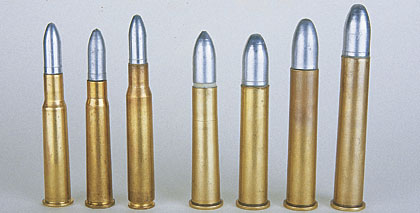
January 04, 2011
By Mike Venturino
Mike's immersion in Black Powder Cartridge Rifle Silhouette and Long Range Black Powder Target shooting has helped him fine-tune his skills at bulletcasting for optimal handloads.
By Mike Venturino
Back in my college years I was poorer than the proverbial church mouse, so there was no big time partying or traipsing off to Florida during spring breaks for this young shooter and handloader. What I did with the small amounts of money I could scrape up was buy some quality guns and the powder and primers needed to shoot them. As for bullets, I made all those myself.
 (From left to right) .30-40 Krag, .303 British, .30-06, .40-65, .45-70, .45-90, .45-100 |
For my rifle shooting I managed to find a Springfield Model 1903A3 .30-06 still in full battle dress. And for a few dollars I acquired a Lyman No. 311291 mold with which to cast 170-grain roundnose gas-checked bullets. I fired thousands of rounds through that rifle, and not even one of them was a factory load or jacketed bullet. It didn't take me long to realize that with the peep sights it was equipped with, I could get my home-cast bullets grouping within a couple of inches at 100 yards. Great fun was had in experimenting with alloy hardness and different powder and primer types.
Advertisement
With that background it's no wonder that even though I can now afford to buy bullets today I still have an extensive bullet mold collection. I can cast bullets for rifles as small as .22 caliber and as large as .58 caliber. It doesn't seem to surprise anyone to hear of good cast bullet accuracy being delivered by big-bore rifles, but I've experienced some fine grouping with cast bullets even from .22 centerfire rifles such as the .222 Remington and .220 Swift.
Right now I am loading cast bullets for a wide variety of rifles and shooting them at targets as close as 100 yards and as distant as 1000 yards. The cartridges those rifles are chambered for range from modern bottleneck, smokeless powder rounds to large-bore, straight-sided blackpowder rounds. To achieve success in reloading all these different cartridges with lead-alloy bullets I poured myself requires vastly different techniques and components. But the actual effort expended to prepare good cast-bullet rifle ammunition is just a bit more than when loading good jacketed bullet ammo. And the satisfaction gained from doing all this yourself is immeasurable.
Advertisement
My most recent shooting interest has been in bolt-action military rifles, so in my rifle racks sit U.S. Krags, Model 1903 Springfields, Model 1917 Enfields, and a modest assortment of foreign-made types. The amount of jacketed bullets fired through these bolt actions has been modest because I've been working up cast-bullet loads for all. Conversely, my shooting passion for almost two decades has been competing in the NRA's Black Powder Cartridge Rifle (BPCR) Silhouette game. And more recently I have joined those fellows shooting the NRA's Long Range Black Powder Target matches.
 Lone Star Rolling Block |
For BPCR Silhouette the metallic targets are placed at 200, 300, 385, and 500 meters. Those sound like faraway targets, but consider that the Long Range matches are fired at paper targets placed at 800, 900, and 1000 yards! The target's black bullseye is 44 inches wide, and its 10-ring is only 20 inches in diameter. Only lead-alloy bullets are allowed for both of these NRA-sanctioned shooting games. My competition rifles for these sports are one or another replica version of the Sharps Model 1874 or Remington Rolling Block. I have them in calibers such as .40-65, .45-70, .45-90, and .45-100. (I'm just getting around to working seriously with that latter cartridge.)
Hard Bullets
So let's look at how to prepare good cast-bullet loads for these two vastly different requirements. With the smokeless powder ammunition I think that the harder the bullet the better. Not only are those bullets going to be driven to fairly high velocities (I use 1600 to 1800 fps as velocity parameters for my military rifles), but they also must withstand the rigors of being cycled from a magazine, up a feedramp, and into a chamber.
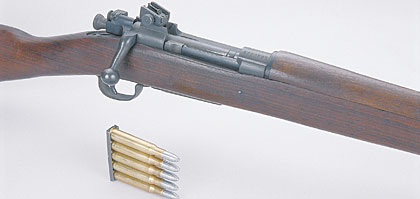 Cast rifle bullets are not just used for competing in BPCR matches. The author fires them in his old M1902 battle rifle as well. |
A softer alloy than linotype is apt to be "grabby" in such a journey and at the least will be scratched and nicked. Therefore, for my bottleneck, smokeless powder shooting only linotype alloy is used. According to Lyman's No. 48 reloading handbook linotype will have a Brinell Hardness Number (BHN) of 22. That's about the hardest lead alloy one will commonly encounter.
Also, since a cast bullet fired from a bottleneck, smokeless powder cartridge is subjected to higher pressures, I believe they should be of gas-check design. The little gilding metal cups protect the bullet's base from being battered by gases or smokeless powder granules. For this very reason most of the cast bullet designs sold by the major bullet mold manufacturers intended for smokeless powder shooting are cut to carry gas-checks. I highly recommend the gas-check be seated with the aid of Lyman's little gas-check seating tool to ensure it is square with the bullet's base.
As for exact bullet shape, very pointed spitzer-type cast bullets seldom give good service at my desired velocity levels while semipointed and roundnose bullets shoot very well in most rifles. And here is one more item based on my experience. Whenever possible, I like my cast bullets for this sort of shooting to be a bit heavier than the jacketed bullet weight normal for that caliber. For instance, in .30-06 150- to 180-grain jacketed bullets might be considered standard. For my .30-06 cast bullets I now prefer those from 180 to 215 grains. Admittedly without having any science to back up my opinion, I think that the heavier bullets make the relatively small smokeless powder charges burn at higher pressures and deliver better accuracy.
Want a good example of what I consider a fine smokeless powder, bottleneck cartridge cast bullet? Since I'm spending so much time working with .30-caliber military rifles, let's look at that bore size. Lyman has two versions of the same bullet; one is meant for American .30 calibers, and the other is for European-type .30 calibers.
The first is No. 311299, meant to be sized about .309/.310 inch, and the latter is No. 314299, meant to be size
d .313/.314 inch. Both have nominal weights of 200 grains when cast of Lyman's No. 2 alloy formula, but from linotype mine weigh 190 grains for the smaller diameter one and 195 grains for the larger. These are semipointed bullets with a long bore-riding nose and short body containing two grease grooves. Bullet No. 311299 is fine for .30-40 Krag and .30-06 while No. 314299 serves excellently in the .303 British cartridge.
BPCR & Long Range Bullets
Now let's look at the vastly different bullets useful for BPCR Silhouette and Long Range. First off, forget the linotype alloy. Experience has proven that very hard cast bullets fired over blackpowder charges delivering velocities only in the 1150 to 1400 fps range can be accurate, but they leave excessive leading. A very hard bullet doesn't obturate to seal the bore at blackpowder pressures, and therefore gas cuts past its base and leaves melted lead plated inside the barrel. Almost universally, BPCR competitors are using blends of pure lead and pure tin in proportions of 1:20 to 1:30. The 1:30 alloy has a BHN of 9 while 1:20 alloy has a BHN of 10. I favor the 1:20 blend.
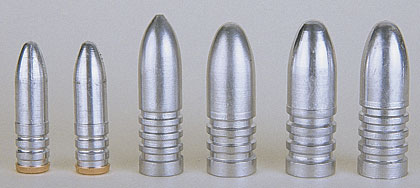 Mike's current favorite cast rifle bullets for shooting from 100 to 1000 yards include .30-, .40-, and .45-caliber bullets. (Left to Right) Lyman No. 311299 .30 Cal. 190-Gr. Semipointed, Lyman No. 314299 .30 Cal. 195-Gr. Semipointed, Brooks .40 Cal. 425-Gr. Semipointed, Brooks .45 Cal. 513-Gr. Creedmoor, Brooks .45 Cal. 530-Gr. Creedmoor, Brooks .45 Cal. 544-Gr. Creedmoor |
The rules for these long-range BPCR matches do not allow gas-check-type bullets, so shooters protect the bullet's bases in another way. We cut or buy wads that are placed between the powder charge and the bullet's base. These come in many types, such as cardboard punched from ordinary tablet backing to commercial vegetable fiber and even plastic wads. In the old days I used to cut .030-inch cardboard wads myself, but since John Walters began selling his vegetable fiber wads I'll never take wad punch in hand again. Walters's wads come in all the correct sizes for blackpowder cartridge rifles and either in .030- or .060-inch thickness. I've settled on the latter for my shooting.
Most competitors shoot roundnose bullets of one form or another in the BPCR games, but at these low velocities sometimes a pointed bullet also will shoot well. Regardless, we like them heavy. In BPCR Silhouette the two most popular bore sizes are .40 and .45 caliber. For .40 caliber most shooters use bullets from 400 to 425 grains, and .45-caliber shooters like 500- to 550-grain bullets. In the NRA's Long Range matches shooters almost universally use .45-caliber rifles and prefer bullets in the 520- to 570-grain weight range.
I mentioned that my favorite .30-caliber bullets had only two grease grooves. That is opposite of what we want with our BPCR bullets. There the bullet lubricant not only serves to keep the bullet from leaving lead fouling in the bore, but it helps keep the blackpowder fouling soft. Therefore, most of the BPCR bullets seen in competition have long bodies with four and five grease grooves.
And lastly, long-range target shooters want our bullets to be consistent. Conversely from the relatively short-range shooting I do with modern bolt actions where I like to use multiple-cavity molds to increase bullet production, I will only use single-cavity molds for long-range target competition. Most high-scoring competitors report that they weigh each and every bullet. My personal limits are that I keep my bullets within a plus/minus .3-grain spread, or a total spread of .6 grain. My 100-yard bullets for the various military rifles are not weighed at all.
As with the .30-caliber bullets, I'll detail what I think are good designs for long-range target shooting with the BPCR. Most competitors in these two games use custom lathe-bored bullet molds, with the two most popular makers being Paul Jones and Steve Brooks. I should mention that I recently discovered a new maker by the name of Dave Mos.
My favorite .40-caliber BPCR Silhouette bullet is a Brooks "Turkey Killer" design of 425 grains (1:20 alloy) with pointed nose and four grease grooves. When shooting .45-caliber rifles in BPCR Silhouette I have been using Creedmoor-style roundnose bullets. These are a 513-grain bullet by Brooks or a similarly shaped 530-grain one from Mos. Both bullets have three very wide and deep grease grooves.
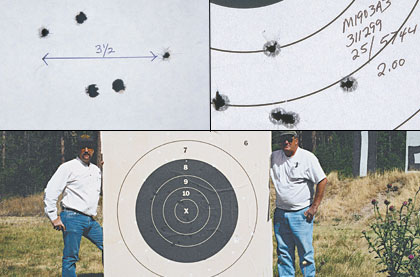 Mike's cast-bullet handloads are capable of fine accuracy. The .30-06 2.00-inch group is at 100 yards while the .40-65 3.5-inch group is at 300yards. |
For the 800-, 900-, and 1000-yard matches I use another Creedmoor-style bullet that weighs 544 grains from a mold made by Steve Brooks. It is a little different than normal in that the diameter of the bullet for the top two grease grooves is the same diameter as the nose. That way it can be seated far out of the cartridge case, making more room for powder. I went this route because I wanted to make a .45-70 powerful enough for the Long Range matches and by seating the bullet so far out was able to increase the blackpowder charge almost 10 grains.
Instead of sizing those bullets used for long-range competition the molds are ordered to drop the bullets at the rifle's barrel groove diameter. For instance, that is .408 inch for .40-65 and .458 inch for all .45 calibers. Then the bullets are run into lube/sizing dies slightly larger--.410 inch for the .40 caliber and .459 inch for .45 caliber. The lube is applied speedily, but the bullets are not touched by the die during the operation.
Preparing The Case
When it comes to preparing the cartridge cases for reloading, the steps are the same for 100-yard and 1000-yard ammunition. I full-length size the brass, mainly because I have more than one rifle in each caliber and want to ensure easy chambering in all of them. Next, the primer pockets are uniformed with a Sinclair Primer Pocket Uniformer. Last, the case mouths are expanded and belled with a Lyman M-Die. The M-Dies have a stepped stem.
The smaller part expands the inside of the cartridge case to a proper dimension to accept cast bullets, and the larger part bells the case mouth so that the bullet's base can be started without damage. Lyman sells M-Dies for virtually all bore sizes from .22 to .50, and I consider them indispensable for all cast-bullet shooting.
| CAST BULLET HANDLOADS FOR 100 YARDS |
|---|
| BULLET | POWDER | MUZZLE VELOCITY (fps) | VELOCITY VARIATION (fps) | 300-yd. ACCURACY |
|---|
| (Type) | (Grs.) |
|---|
| .30-40 Krag, U.S. M1896 Springfield, 30-inch Barrel |
|---|
| Lyman No. 311299 190-gr. Semipointed | XMP-5744 | 22.0 | 1789 | 10 | 2.25 |
|---|
| .303 British, SMLE No. 4 Mark 1 25-inch Barrel |
|---|
| Lyman No. 314299 195-gr. Semipointed | XMP-5744 | 22.0 | 1728 | 24 | 3.13 |
|---|
| .30-06, U.S. M1903A3 Springfield, 24-inch barrel |
|---|
| Lyman No. 311299 190-gr. Semipointed | XMP-5744 | 25.0 | 1785 | 31 | 2.08 |
|---|
| NOTES: Accuracy is the average of three five-shot groups fired froma sandbag benchrest at 100 yards. Velocity is the average of five rounds measured six feet from the guns muzzle |
| LONG RANGE CAST BULLET HANDLOADS |
|---|
| BULLET | POWDER | MUZZLE VELOCITY (fps) | VELOCITY VARIATION (fps) | 300-yd. ACCURACY |
|---|
| (Type) | (Grs.) |
|---|
| .40-65 Lone Star Rolling Block, 32-inch Barrel |
|---|
| Brooks 425-gr. Semipointed | Swiss 1 1/2 Fg | 57.0 | 1204 | 9 | 3.42 |
|---|
| .45-70 C. Sharps Arms Model 1874, 32-inch Barrel |
|---|
| Brooks 513-gr. Creedmoor | Swiss 1/2 Fg | 70.0 | 1212 | 13 | 4.33 |
|---|
| Mos 530-gr. Creedmoor | Swiss 1 1/2 Fg | 67.0 | 1167 | 15 | 4.08 |
|---|
| Brooks 544-gr. Creedmor | Swiss FFFg | 68.0 | 1254 | 10 | 4.21 |
|---|
| .45-90 Shiloh Model 1874, 30-inch Barrel |
|---|
| Mos 530-gr. Creedmor | Swiss 1 1/2 Fg | 78.0 | 1246 | 18 | 4.50 |
|---|
| Brooks 544-gr. Creedmoor | Swiss 1 1/2 Fg | 75.0 | 1208 | 13 | 3.88 |
|---|
| NOTES: Accuracy is the average of three five-shot groups fired from a sandbag rest at 300 yards. Velocity is the average of 10 rounds measured six feet from the guns' muzzles |
|---|
When it comes time to put powder charges into the cases, I again use two very different methods. For the modern, bottleneck .30-caliber cartridges I simply drop the desired charge from a Redding Competition BR-30 powder measure. It holds the smokeless powder charges within a couple tenths of a grain, which is fine for 100-yard shooting.
For the blackpowder loads meant for long-range shooting I hand weigh each one to plus/minus .1 grain. Then I drop each of those hand-weighed powder charges down a 24-inch drop tube, taking about five seconds to trickle each one in. I don't know why, but drop-tubed blackpowder charges burn more cleanly and consistently. And I should mention that this is not a new trick; the original Sharps Rifle Co. also marketed drop tubes among its other reloading tools.
Powders
I will include only a few words about powders for all this shooting because the range of choices is just so great. There are well over 100 different smokeless powders now, and blackpowders are available from here, Germany, and Switzerland. My choice for modern, bottleneck smokeless powder cartridges is Accurate Arms XMP-5744. It burns very consistently without needing any sort of case filler and has a small enough granule size that it powder measures well. For blackpowder shooting I have settled on Swiss 11/2 Fg for the NRA BPCR Silhouette game. For NRA Long Range Target shooting with the .45-70 I use Swiss FFFg because it gives the cartridge extra oomph. When firing the .45-90 cartridge in that game I return to Swiss 11/2 Fg.
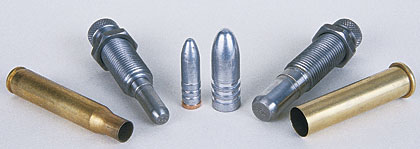 According to the author, case neck expanding and belling dies are required for constructing good-quality cast-bullet handloads. |
Bulletseating
Now we get to the bulletseating step. For my modern bottleneck cartridges the bullet is seated in the normal manner in a standard seating die with all grease grooves covered, and then I apply a rather heavy crimp. That is to ensure the bullet stays in place during the sometimes rough trav
el from military rifle magazine into chamber. For my long-range blackpowder match ammunition each bullet is seated with the aid of a Redding micrometer adjustable Competition Seating Die. The spring-loaded inner sleeve of that die helps ensure the alignment of bullet to cartridge case. Before using these rounds in competition, I further check them with a Sinclair concentricity gauge. I find that my rounds seldom have more than .001 inch of run out.
Unlike with the modern bottleneck smokeless powder cartridges where I let the bullet's crimping groove dictate the seating depth of the bullet, with the blackpowder match rounds I have invested considerable experimentation to determine seating depth. For instance, my Lone Star Rolling Block and Shiloh Sharps Model 1874 .40-65s give best groups with the 425-grain Brooks Turkey Killer bullet to be seated with one grease groove exposed.
My custom Remington Rolling Block and C. Sharps Arms Model 1874 .45-70s and my Shiloh Model 1874 Sharps .45-90 like the Brooks and Mos Postell bullets to be seated with all grease grooves covered. That C. Sharps Arms Model 1874 .45-70 is one I have won some awards with (but nary a first place yet!) in the 800-, 900-, and 1000-yard events. And I did the shooting with the Brooks 544-grain Creedmoor seated with two full grease grooves exposed.
After all is said and done, just how well does my 100- to 1000-yard ammunition shoot? I've enclosed some of my favorite loads as samples in the accompanying chart, but I'll give these details. No major problem has been encountered in getting my 1903 Springfield .30-06s or the U.S. Krag .30-40 to give groups from 11/2 to 2 MOA at 100 yards. The British SMLE No. 4 Mark 1 .303 and the Model 1917 Enfields are more like 2 to 3 MOA shooters.
I won't compete with one of my BPCR Long Range rifles unless it will deliver groups of about 11/2 MOA at 300 yards. (The longest range I can test loads at on my own property.) And I've managed to shoot myself into the Master Class in both of those very difficult shooting sports.
Perhaps I was lucky in my early years in that I was forced to go the cast-bullet route in my reloading endeavors. It made me appreciate that species of projectile and has caused me to get the very most enjoyment out of handloading.
Recent Videos
![The Mossberg 500 Pump Action Shotgun is one of the most popular home defense shotguns on the market. Joseph Von Benedikt...]()
Guns
Joseph Von Benedikt is with Rafe Nielsen of Browning to take a look at a new X-Bolt series rifle. Lighter and tougher and more precise than ever, it's the perfect back country hunting rifle.
![The Mossberg 500 Pump Action Shotgun is one of the most popular home defense shotguns on the market. Joseph Von Benedikt...]()
Guns
Taurus has redesigned this sporting pistol for performance. Joseph Von Benedikt is with Jorge Spat to learn all about it.
![The Mossberg 500 Pump Action Shotgun is one of the most popular home defense shotguns on the market. Joseph Von Benedikt...]()
Gear
This isn't your grandpa's muzzleloading system. Federal has created a safer, easier and more reliable way to shoot a muzzleloader.
![The Mossberg 500 Pump Action Shotgun is one of the most popular home defense shotguns on the market. Joseph Von Benedikt...]()
Gear
Joseph VonBenedikt is with Joel Hodgdon to talk about the improved accuracy and long-range potential of the already reliable Core-Lokt ammo line.
![The Mossberg 500 Pump Action Shotgun is one of the most popular home defense shotguns on the market. Joseph Von Benedikt...]()
Guns
Walther's new Performance Duty Pistol is ready for both concealed carry and conventional service situations. Available in different sizes and red dot ready, it'll fit your needs, whatever they are.
![The Mossberg 500 Pump Action Shotgun is one of the most popular home defense shotguns on the market. Joseph Von Benedikt...]()
Learn
Joseph Von Benedikt visits with Aaron Oelger from Hodgdon about the unprecedented demand on the shooting supply industry.
![The Mossberg 500 Pump Action Shotgun is one of the most popular home defense shotguns on the market. Joseph Von Benedikt...]()
News
A World Record Attempt and everyone is out at the range shooting and practicing.
![The Mossberg 500 Pump Action Shotgun is one of the most popular home defense shotguns on the market. Joseph Von Benedikt...]()
Learn
Before there were scopes or red dots there were iron sights. But do you know how to properly use them? We show you how.
![The Mossberg 500 Pump Action Shotgun is one of the most popular home defense shotguns on the market. Joseph Von Benedikt...]()
Learn
Learn the difference between revolvers and semi-auto pistols and what makes them different. Learn more here: http://bit.ly/1G7xXag
![The Mossberg 500 Pump Action Shotgun is one of the most popular home defense shotguns on the market. Joseph Von Benedikt...]()
News
Mikey Hartman, Lt. Col. (Ret.) of Israeli Defense Forces, joins David Fortier for an exclusive interview for Shotgun News.
![The Mossberg 500 Pump Action Shotgun is one of the most popular home defense shotguns on the market. Joseph Von Benedikt...]()
Guns
The Mossberg 500 Pump Action Shotgun is one of the most popular home defense shotguns on the market. Joseph Von Benedikt shows his custom 500 and how well it shoots. Make sure to watch till the end. Who knew wild turkey's were so stupid!?
Buy Digital Single Issues
Don't miss an issue.
Buy single digital issue for your phone or tablet.
Buy Single Digital Issue
on the Shooting Times App
More You May Be Interested In

Get Digital Access.
All Shooting Times subscribers now have digital access to their magazine content. This means you have the option to read your magazine on most popular phones and tablets.
To get started, click the link below to visit mymagnow.com and learn how to access your digital magazine.
Get Digital Access
Enjoying What You're Reading?
Get a Full Year
of Guns & Ammo
& Digital Access.
Offer only for new subscribers.
Subscribe Now